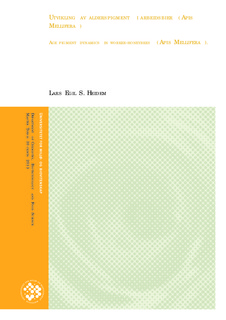Age pigment dynamics in worker-honeybees ( Apis Mellifera )
Master thesis
Permanent lenke
http://hdl.handle.net/11250/186520Utgivelsesdato
2013-08-27Metadata
Vis full innførselSamlinger
- Master's theses (KBM) [891]
Sammendrag
Growing old is often related to a decline in physiological function, performance, survival or
reproduction.(Kirkwood 2002) But studies among animals have showed that an increased
chronological age doesn’t automatically leads to these physical changes.(Rueppell, Christine et
al. 2007) Honeybees (Apis mellifera) has showed a remarkable plasticity of aging with queens
having an average lifespan of 1–2 years, while workers have an average lifespan of 140 days in
the winter and 15–38 days in the summer(Munch and Amdam 2010).
Regarded as a marker of cellular aging, lipofuscin, a fluorescent non-degradable material, will be
expected to accumulate in the cells of aging animals(Gray and Woulfe 2005; Double, Dedov et
al. 2008).
By obtaning bees of the same age, and manipulating them into different social roles in the hive,
this study could observe how the accumulation of lipofuscin can be a process controlled by other
factors then just increased chronological age. Age-matched bees from with different social roles
in the hive were sampled, and using a Leica SP5 Confocal laser scanning microscope, it was
possible to create images that enabled the quantification of lipofuscin within the tissue samples
from the bees.
The results showed a rapid accumulation pattern of lipofuscin among bees that had been engaged
in foraging activities for more than 13 days, with the bees that was engaged in nursing activities
showing no such accumulation. This illustrates the strong effect of these social factors among
honey bees, and with studies on functional senescence that show significant decline patterns for
older forager groups after about 2 weeks of foraging(Behrends, Scheiner et al. 2007; Williams,
Roberts et al. 2008), this study suggests that the accumulation of lipofuscin is more related to the
onset of senescence, then just being a harmless wear-and-tear product purely related to the
chronologically age of an animal.
